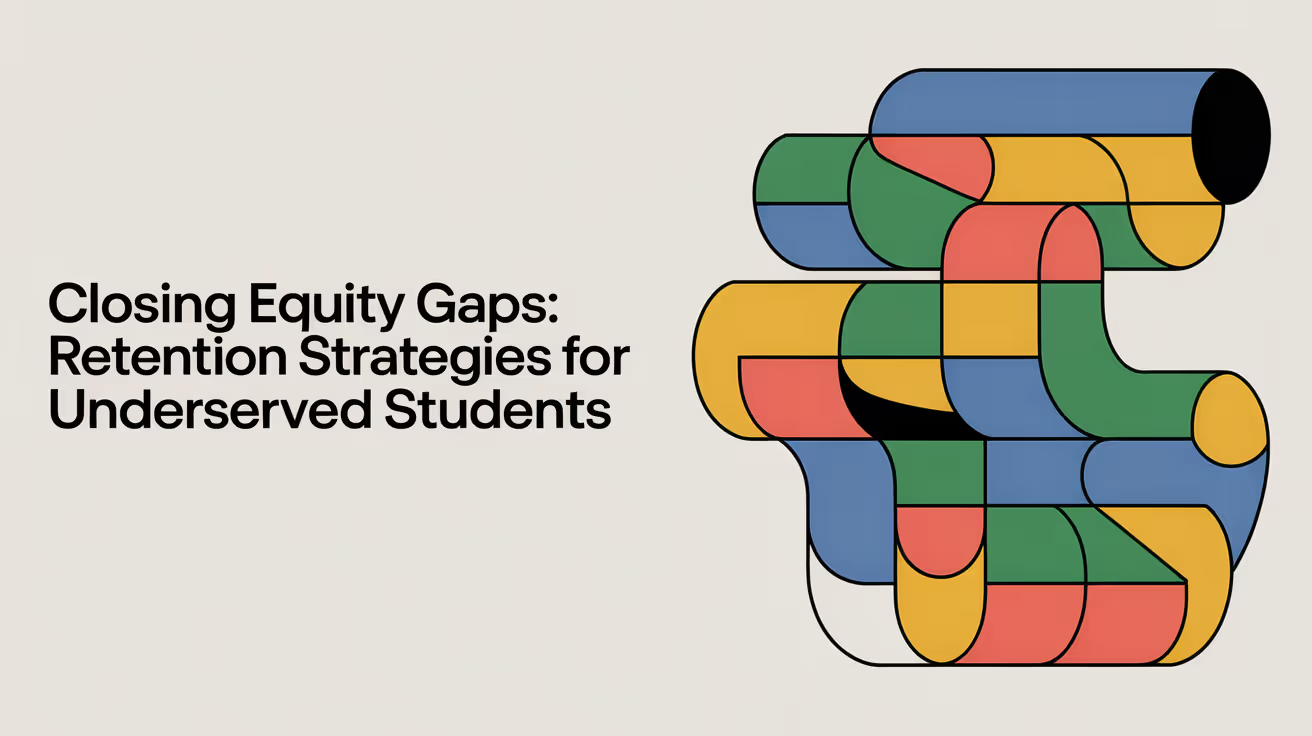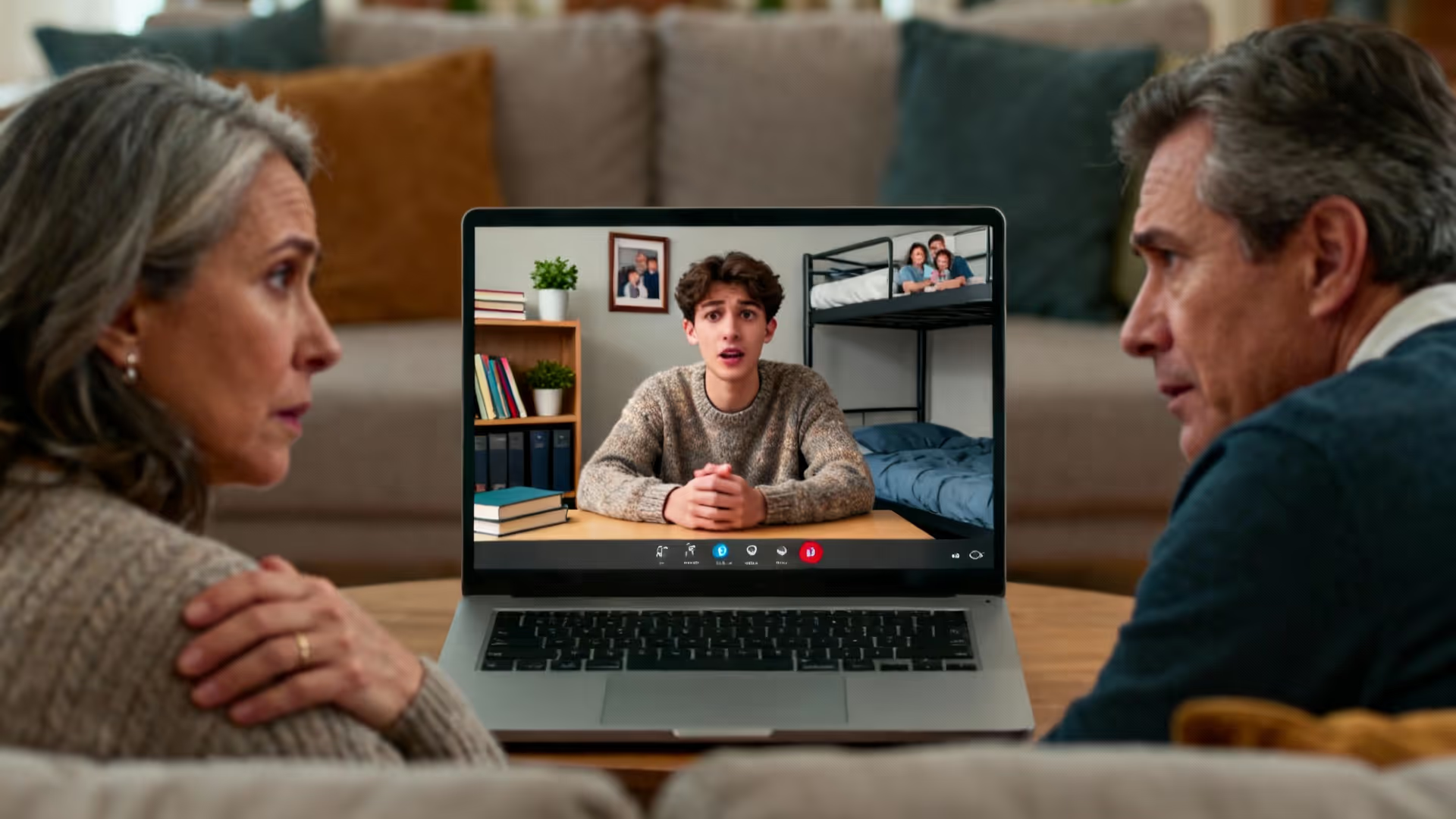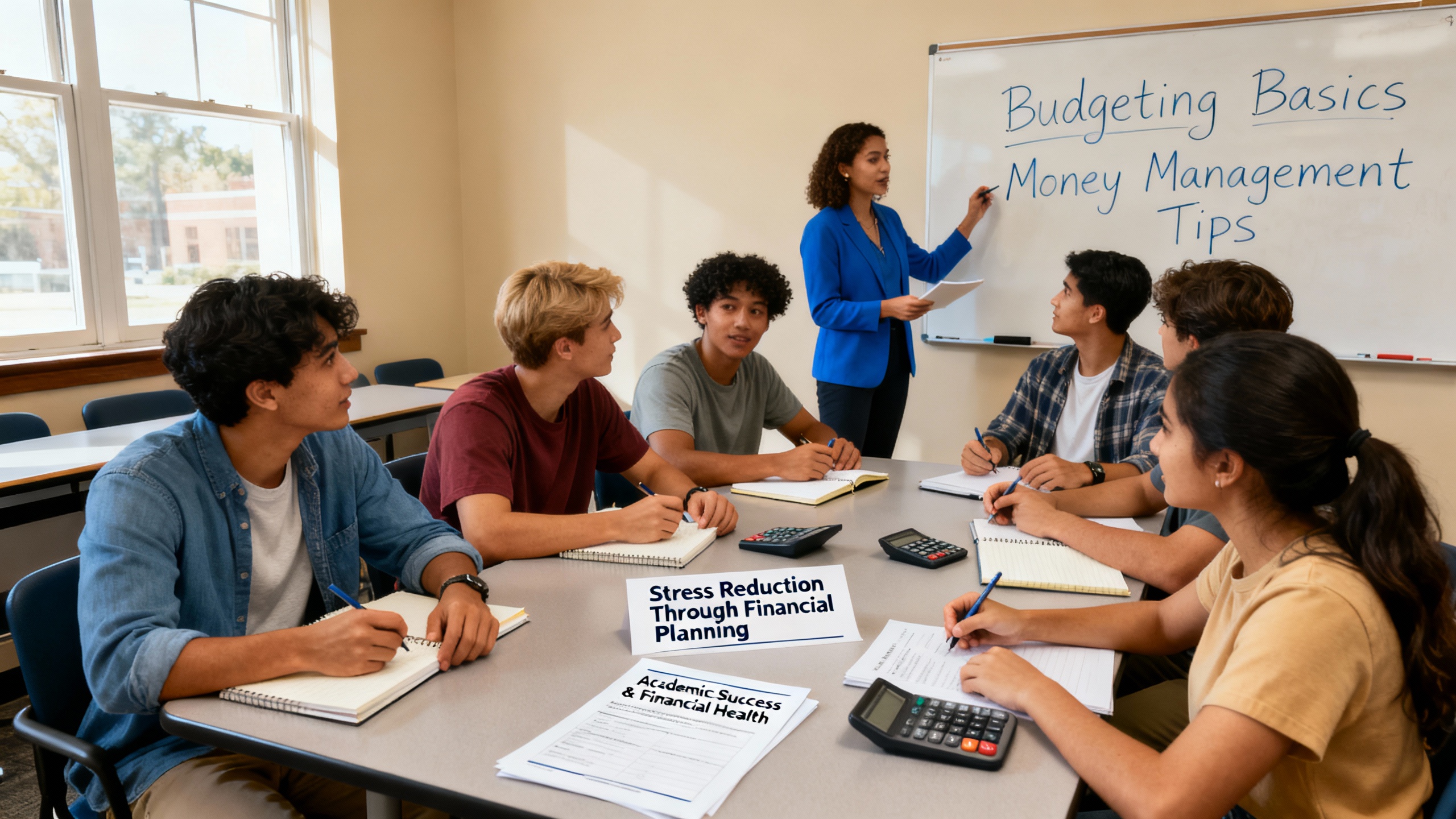TL:DR
Equitable retention requires targeted programs that address systemic barriers faced by first-generation and low-income students. Effective first-generation student retention strategies include bridge programs, peer mentoring, learning communities, supplemental instruction, emergency financial aid, and disaggregated data tracking to monitor progress and close persistence gaps across student populations.
Understanding the Retention Equity Challenge
Higher education faces a persistent challenge: students from underserved backgrounds complete degrees at significantly lower rates than their more advantaged peers. The data paints a stark picture of inequity that demands urgent attention from campus leadership.
According to recent analyses, only 11 percent of low-income, first-generation students earn a bachelor's degree within six years, compared to 55 percent of continuing-generation students [1]. This dramatic gap represents not just lost potential, but a fundamental failure to serve all students equally. At public universities, retention rates show a 10 percentage-point gap between low-income and non-low-income students, while advancement rates reveal even wider disparities [2].
The consequences extend beyond individual students. Those who leave without completing their degrees often carry student debt while missing out on the economic mobility that graduation provides [1]. For institutions facing demographic enrollment pressures, improving equitable retention isn't just a moral imperative—it's essential for financial sustainability. That’s why many institutions are now focusing on first-generation student retention strategies as part of their long-term equity plans.
Why Traditional Approaches Fall Short
Many retention programs are designed for the "average" student without accounting for the specific circumstances and characteristics that first-generation and low-income students navigate. These students often face challenges their more privileged peers never encounter: balancing work and school, supporting family members, managing food or housing insecurity, and navigating unfamiliar academic systems without a roadmap [1].
Strategies that work for general campus populations may not translate to success for underserved groups [3]. Equitable retention demands intentional, targeted approaches that recognize and address these realities. Effective first-generation student retention strategies must therefore consider social, academic, and financial barriers collectively.
Bridge Programs: Smoothing the Transition
Summer bridge programs have emerged as one of the most effective interventions for supporting underserved students. These programs typically run for one to six weeks before the start of the academic year and focus on developing both academic skills and social connections.
Research shows that at community colleges and less selective four-year institutions, students who participate in bridge programs are 10 percentage points more likely to finish within six years [4]. The most effective programs combine academic preparation in subjects like math and writing with opportunities to build peer networks, meet faculty, and experience campus life [5].
Bridge programs work because they address multiple barriers simultaneously. Students gain confidence in their academic abilities, develop study strategies, and establish a support network before the pressures of the regular semester begin [5]. For institutions serving high percentages of first-generation students, bridge programs represent a critical early intervention point and a cornerstone of first-generation student retention strategies.
Learning Communities and Peer Support

Creating integrated learning communities has been shown repeatedly to improve student success, particularly for underserved populations. These communities typically involve cohorts of students taking linked courses together, often with peer mentors or learning assistants embedded in the classroom.
The impact on retention is substantial. Studies demonstrate that peer mentoring helps students feel more integrated and connected to the university while increasing both academic performance and retention rates [6]. One Chilean study found that first-year students participating in peer mentoring programs achieved better average grades, higher attendance levels, and improved retention compared to similar students who didn't participate [7].
Learning communities work by combating isolation and building belonging. For first-generation students who may question whether they belong in higher education, seeing peers "like them" succeed provides powerful evidence that they can succeed too [8]. These communities also create natural study groups and social connections that help students navigate challenges together —making them vital to first-generation student retention strategies.
Supplemental Instruction: Targeted Academic Support
Supplemental instruction (SI) offers a proven approach to helping students succeed in historically difficult courses. Unlike traditional tutoring, SI is voluntary, non-remedial, and focuses on developing both content knowledge and learning strategies.
Research on SI implementation shows significant success in increasing student persistence rates [9]. The approach is particularly effective for STEM courses where many underrepresented students struggle. One university reported sustaining and expanding its SI program in calculus to additional lower-division math, computer science, and physics courses after seeing strong results [10].
The key to effective SI is using trained peer leaders who model successful learning strategies while facilitating collaborative study sessions. This peer-led approach creates a less intimidating environment than seeking help from professors and normalizes the idea that all students need support to succeed. Institutions can strengthen their first-generation student retention strategies by integrating SI programs into core courses.
Mentoring: Building Connections That Matter
Both peer and faculty mentoring play crucial roles in supporting equitable retention. Research consistently shows that mentoring increases academic achievement, engagement, and persistence for minority students [11].
Effective mentoring programs share several characteristics: matching students with mentors from similar backgrounds, providing comprehensive training for mentors, creating structured meeting schedules with clear goals, and supporting mentors with ongoing professional development [12]. The benefits extend beyond academics to include career guidance, personal support, and help navigating institutional systems.
For underrepresented students in STEM fields, near-peer mentoring—where advanced undergraduates or master's students mentor newer students—has proven particularly valuable [13]. These mentors provide relatable role models, normalize challenges, and help combat negative stereotypes by demonstrating that students "like them" can succeed in demanding fields.
Minority-serving institutions (MSIs) have long understood the power of mentorship and representation. These institutions, which include Historically Black Colleges and Universities (HBCUs), Hispanic-Serving Institutions (HSIs), and others, enroll disproportionately high numbers of underrepresented students and often achieve strong retention outcomes through culturally responsive support [14]. Mentorship remains a key pillar of first-generation student retention strategies.
Emergency Financial Aid: Removing Unexpected Barriers
Financial emergencies represent a leading cause of student departure, with an estimated three million students stopping out each year due to financial crises that would cost less than $1,000 to resolve [15]. Emergency aid programs, often called micro-grants, provide quick financial assistance to help students overcome unexpected expenses and remain enrolled.
Recent research shows promising evidence for emergency aid's impact. At Georgia State University, students who received Panther Retention Grants were significantly more likely to graduate within one to three terms than non-recipients [16]. During the COVID-19 pandemic, one distribution of emergency aid at Western Governors University resulted in an 11 percentage-point increase in graduation among recipients [16].
The most effective emergency aid programs are fast, easy to access, and directly address immediate needs. Awards typically range from $500 to $3,000 and can cover expenses like car repairs, medical bills, housing deposits, or textbook costs [15][17]. By removing these financial roadblocks quickly, institutions enable students to focus on their studies rather than dropping out to manage crises - making financial aid a crucial component of first-generation student retention strategies.
Tracking Progress with Disaggregated Data

Achieving equitable retention requires measuring progress for specific student populations. Institutions should track retention and graduation rates disaggregated by income level, first-generation status, race/ethnicity, and other relevant demographics.
This data-driven approach allows campus leaders to identify where gaps exist, monitor whether interventions are working, and adjust strategies accordingly. Setting explicit equity targets—such as eliminating retention gaps by 2030—creates accountability and focuses institutional efforts [18].
Cornell's Kessler Scholars Program offers a model worth emulating. The program maintained an 85 percent retention rate for first-generation, low-income students, with 80 percent of the inaugural cohort graduating within four years and 95 percent earning degrees within five years [19]. These outcomes demonstrate what's possible when institutions commit to comprehensive, coordinated support through first-generation student retention strategies.
Implementation: Making It Work on Your Campus
Campus leaders ready to advance equitable retention should consider these action steps:
Conduct an equity audit. Review your institutional data to identify specific populations experiencing retention gaps. Look beyond overall rates to understand where students are struggling and why.
Start with evidence-based programs. Bridge programs, peer mentoring, learning communities, and supplemental instruction all have strong research support. Choose interventions that align with your student population's needs and your institution's capacity.
Secure emergency funding. Establish an emergency aid fund with clear eligibility criteria and a rapid application process. Even modest amounts can prevent students from leaving.
Build partnerships. Connect with community organizations, employers, and alumni to expand support networks and create opportunities for internships, mentoring, and financial assistance.
Invest in professional development. Train faculty and staff to recognize and address the specific challenges faced by first-generation and low-income students. Combat deficit mindsets by helping educators understand and value the assets these students bring.
Create accountability structures. Set specific, measurable equity goals. Review progress regularly at the highest levels of campus leadership. Celebrate successes and adjust approaches when outcomes fall short. These implementation steps strengthen first-generation student retention strategies and ensure institutional commitment to equity.
The Path Forward
Closing equity gaps in retention is both urgent and achievable. The research is clear: targeted, evidence-based interventions can dramatically improve outcomes for underserved students. What's needed now is institutional will and sustained commitment.
For campus executives navigating enrollment pressures and budget constraints, investing in equitable retention makes strategic sense. Every student who persists to graduation represents tuition revenue, stronger institutional outcomes, and fulfilled educational mission. Moreover, as student populations continue to diversify, institutions that excel at serving all students equitably will be best positioned for long-term success.
The work ahead requires transforming campus cultures, not just implementing programs. It means moving from models that demand exceptional resilience from disadvantaged students to environments designed for all students to thrive. It means using data not to label students as "at risk" but to understand where institutional supports need strengthening.
Most importantly, it means recognizing that equitable retention isn't someone else's problem or a diversity office initiative—it's central to the educational mission of every institution committed to student success.
Works Cited
[1] American Sociological Association — "Low-Income, First-Generation College Students." https://www.asanet.org/footnotes-article/low-income-first-generation-college-students/. Published: 2022-11-28. Accessed: 2025-10-24.
[2] Illinois Board of Higher Education — "Equity Gaps: Low-income Students." https://ibhestrategicplan.ibhe.org/SP_Equity_Gaps_Low-income_Students.html. Published: [Date not specified]. Accessed: 2025-10-24.
[3] National TRIO Clearinghouse — "Retention of Students from First Generation and Low Income Backgrounds." https://eric.ed.gov/?id=ED446633. Published: 2000-05. Accessed: 2025-10-24.
[4] American Journal of Education — "The Bridge and the Troll Underneath: Summer Bridge Programs and Degree Completion." https://www.journals.uchicago.edu/doi/10.1086/677959. Published: [Date not specified]. Accessed: 2025-10-24.
[5] ResearchGate — "Implementation and effects of a bridge program to increase student learning and retention in engineering programs." https://www.researchgate.net/publication/283106001. Published: 2015-01-01. Accessed: 2025-10-24.
[6] APLU — "PEER MENTORING FOR STUDENT SUCCESS." https://www.aplu.org/wp-content/uploads/Cluster-9-Peer-Mentoring-Report-v2.pdf. Published: [Date not specified]. Accessed: 2025-10-24.
[7] The Chronicle of Evidence-Based Mentoring — "The Impact of Peer-Mentoring on the Academic Success of Underrepresented College Students." https://www.evidencebasedmentoring.org/the-impact-of-peer-mentoring-on-the-academic-success-of-underrepresented-college-students/. Published: [Date not specified]. Accessed: 2025-10-24.
[8] International Journal of STEM Education — "Increasing STEM success: a near-peer mentoring program in the physical sciences." https://stemeducationjournal.springeropen.com/articles/10.1186/s40594-016-0043-2. Published: 2016-08-11. Accessed: 2025-10-24.
[9] Instructure Community — "Fostering Success and Retention Through Supplemental Instruction." https://community.canvaslms.com/t5/CanvasLive/Fostering-Success-and-Retention-Through-Supplemental-Instruction/ba-p/281562. Published: 2018-10-17. Accessed: 2025-10-24.
[10] ADS — "Improving Retention through Student Learning Communities." https://ui.adsabs.harvard.edu/abs/2007nsf....0653260W/abstract. Published: [Date not specified]. Accessed: 2025-10-24.
[11] ResearchGate — "The Summer Bridge Program: An Effective Agent in College Students' Retention." https://www.researchgate.net/publication/336242133. Published: 2019-05-01. Accessed: 2025-10-24.
[12] Journal of Learning Development in Higher Education — "The benefits of peer mentoring in higher education: findings from a systematic review." https://journal.aldinhe.ac.uk/index.php/jldhe/article/view/1159. Published: 2024-09-29. Accessed: 2025-10-24.
[13] PMC — "Near-peer STEM Mentoring Offers Unexpected Benefits for Mentors from Traditionally Underrepresented Backgrounds." https://pmc.ncbi.nlm.nih.gov/articles/PMC5034940/. Published: [Date not specified]. Accessed: 2025-10-24.
[14] SHEEO — "Overview of Minority-Serving Institutions in the United States." https://sheeo.org/wp-content/uploads/2024/09/MSI-White-Paper.pdf. Published: 2024. Accessed: 2025-10-24.
[15] Scholarship America — "Emergency Aid Scholarships." https://scholarshipamerica.org/sponsors/set-up-a-scholarship/emergency-aid-scholarships/. Published: 2024-11-26. Accessed: 2025-10-24.
[16] Bipartisan Policy Center — "How Well Do College Emergency Aid Micro-Grant Programs Work?" https://bipartisanpolicy.org/explainer/college-emergency-aid-micro-grant-programs/. Published: [Date not specified]. Accessed: 2025-10-24.
[17] UNCF — "Emergency Student Aid (ESA)." https://uncf.org/pages/cesa. Published: 2021-06-11. Accessed: 2025-10-24.
[18] Topic Bank — Campus Mind internal data. Row T15 strategic angles. Accessed: 2025-10-24.
[19] Cornell Chronicle — "With $1.1M grant, first-gen, low-income students get renewed support." https://news.cornell.edu/stories/2025/07/11m-grant-first-gen-low-income-students-get-renewed-support. Published: 2025-07. Accessed: 2025-10-24.
Frequently Asked Questions
Q1: What are the main barriers to retention for first-generation students?
First-generation students often face multiple barriers including limited college knowledge, financial constraints, competing family obligations, and feelings of not belonging. They may lack guidance on navigating academic systems, accessing resources, and making course or major decisions. Many also balance work and school while supporting family members, creating time and energy pressures that more privileged students don't experience.
Q2: How effective are summer bridge programs for improving retention?
Research demonstrates that bridge programs significantly improve retention outcomes. At community colleges and less selective four-year institutions, participants are approximately 10 percentage points more likely to complete their degrees within six years compared to non-participants. The most effective programs combine academic skill-building with social connection and campus familiarization during intensive summer sessions before the academic year begins.
Q3: What makes peer mentoring effective for underrepresented students?
Peer mentoring works because it provides relatable role models who have successfully navigated similar challenges. Studies show mentored students achieve better grades, higher attendance, and improved retention rates compared to similar students without mentors. The relationship helps combat isolation, normalize seeking help, and build a sense of belonging—particularly crucial for students who may question whether they fit in higher education.
Q4: How much should emergency grants be to make a difference?
Research indicates that emergency aid amounts between $500 and $3,000 can effectively prevent students from dropping out. Many students stop out due to financial crises costing less than $1,000 to resolve—car repairs, medical bills, housing deposits, or textbook costs. The key is providing funds quickly with minimal bureaucracy when unexpected expenses arise that would otherwise force students to leave school.
Q5: What role do minority-serving institutions play in equitable retention?
Minority-serving institutions (MSIs) including HBCUs, HSIs, and Tribal Colleges excel at serving underrepresented students through culturally responsive support, strong mentoring networks, and mission-driven commitment to equity. These institutions often achieve strong retention outcomes by creating environments where diverse students see themselves represented in faculty, staff, and peers, while providing comprehensive academic and social support tailored to their communities' needs.




